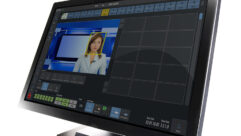Time Control systems: We all take that clock on the wall for granted. Butfor schools, transit facilities and industrial plants, knowing the correcttime is crucial.
Aug 1, 1997 12:00 PM,
R. David Read
Tempus fugit, as the Romans coined it – time flies. How can we control itWecan’t. However, we can measure it.
The first use of clocks (or chronometers) was developed to providenavigational assistance at sea. Such instruments were based on solarobservations and were peculiar to the exact position of the ship making theobservation.
Before the mid-1800s, time was a relative matter that was of scantconcerned to anyone other than a local resident. What time it was inWashington, DC, was basically unimportant to a farmer in Iowa. Hence, eachtown or locale based its time-frame on a local observation of the solarsystem. Noon in Podunk, IA, was not the same time as noon inBuzzard-Breath, NE.
The advent of standard-timeThe coming of the railroads in the 1800s, and particularly their rapidwestern expansion on the North American continent, presented a timeproblem. If the time of day in adjacent communities varied, how could youschedule train movementsIf you have two trains headed toward each otherwith orders to meet or pass at a particular time, both train crews hadbetter agree on what time of day it is.
The U.S. rail industry set about to adopt the concept of standard timezones based upon geographical sections of the country. Once the concept ofstandard-time was adopted, the next problem was how to measure and regulateclocks to show the proper timeIn the era of which we speak, clocks andwatches were analog, mechanical devices that required frequent correctionto display the correct time. Incorrect time was a serious problem; in the1880s, a railway conductor was actually indicted for manslaughter inconnection with an accident in which it was determined his watch wasincorrect.
Railroads starting installing standard clocks at their major terminals.Regulator clocks were installed at most depots, and employees were requiredto equip themselves with railway standard watches. All of these clocks andtimepieces had to be calibrated on a frequent basis to insure that they allshowed the correct time.
How was this to be accomplishedIn stepped the telegraph companies, notablyWestern Union and Postal Telegraph. Both of these telegraph companies hadrealized the commercial value of the railroad’s telegraphic network and hadcommenced making commission agreements with the railroads to handlecommercial telegraph traffic.
Using the resources of the U.S. Naval Observatory, the telegraph companiesstarted transmitting time signals to their host railroads. This consistedof a correction signal that was transmitted once every 24 hours. Thecorrection signal took the form of a string of dots at one second on, onesecond off intervals and was transmitted via Morse telegraphy for threeminutes prior to the hour (12:00 p.m. EST). This was followed by a 10second silent period, then a dash at precisely 12:00 p.m. Station agentswere thus given a way to spike (correctly set) the clocks at theirlocation. Employees could set their time-pieces with reference to astandard clock. Finally, everyone within a given time zone was telling timein a consistent manner.
Corrective clocksystem developmentThe telegraph companies soon came to realize that this time service couldalso be valuable to industrial and retail customers. They had already”wired” many of their customers for the receipt of stock quotations, and inthose days, when the telephone was not universally available,service-wanted call circuits were used to notify the telegraph company thata messenger boy was to be dispatched to pick up a message that was to besent as a telegram. This was accomplished by winding a spring driven clockon a call switch. When released, the device would send, in Morse code, thelocation where the pickup service was required.
Considering that many of their commercial customers were already wired intothe system, it was a logical move to add time-control to the servicesalready in place. Telegraph companies commenced aggressively selling timeservice and clocks to commercial accounts. These later clocks weremechanically designed to respond to the Morse-code dots and the spikingdash to provide automatic updating for both minutes and hours. Although nowquite rare, you can still run across clocks emblazoned with the WesternUnion or Postal Telegraph logos.
After vigorously competing with each other for close to a hundred years,Western Union and Postal merged in the late 1930s. As individualtime-pieces became more reliable and affordable, the public time service ofthe telegraph companies began to dwindle. By the end of World War II, theuse of these systems in commercial applications had practically disappeared.
However, when I left the railroad in 1962 to pursue a career in audio, thespiking of standard clocks via Western Union transmission was still verymuch alive. Those of you who live or have visited Los Angeles may recallthat the clock-tower at Los Angeles Union Passenger Terminal (LAUPT) had afour-sided, large-scale art-deco clock display. That display was controlledby a Western Union-controlled master clock in the telegraph office atLAUPT. The telegraph office is long-gone, but I suspect that master clockis still buried somewhere in the bowels of the passenger station.
While the telegraph companies were abandoning the idea of corrective clocksystems, the commercial sector still had a need for such services. IBM (theInternational Business Machine Corporation), as an outgrowth of itsemployee time clock business (founded by its predecessor, the ComputingTabulating Recording Company) continued addressing the needs of commercialaccounts by manufacturing and selling corrective clock systems.
These systems were based on an on-premise master clock that in turn wouldcontrol a host of secondary clocks. Prior to the late 1920s, the powercompanies’ line frequency was not well-regulated, hence the ac linefrequency of 60 Hz (at least in most parts of North America – in some partsof rural North America, power company AC line frequency could be anythingfrom 25 to 50 or 60 cycles) was not a reliable timing reference.
Consequently, these early systems were all minute impulse systems in whichall of the secondaries were under direct control of their associated masterclock. Where did the master clock get its referenceUsually from areasonably stable quartz crystal circuit.
It would be 1948 before IBM would introduce its version of a synchronous(60 Hz ac line-frequency controlled) type system. At one point, IBM evendabbled with the idea of using audio pulse transmission to correct and setsecondary clocks.
The Simplex Time Recording Company, also a long-time major player in theemployee time-clock and the corrective clock business, was to become one ofthe predominate players in the time-control systems and fire alarm marketswhen IBM was forced to divest itself of those businesses in 1958.
Others in this market (some of whom still exist) include Stromberg-Carlson,Edwards, Latham, Standard Electric, Faraday, Dukane and Cincinnati.Rauland-Borg was a latecomer to the market when they introduced theirelectronic-digital display systems in the 1970s.
Types of clock systemsThe general categories of corrective clock systems are minute impulse andsynchronous. The most telling distinction between the two is the absence ofa second hand on the minute impulse secondary and the fact that the minutehand “jumps” from one minute marker to the next in a minute impulse system,with an accompanying audible “clunk.” The primary differences aresummarized in Table 1.
Correction cyclesNaturally, all of these earlier time-control systems were analog in nature.The associated master clocks were electromechanical devices. Asmanufacturers developed their products, the tendency was for them to eachadopt their own proprietary correction cycles. Consequently, there are atleast as many correction programs as there are manufacturers. This completenon-standardization meant that only manufacturer A’s secondary clocks wouldwork with manufacturer A’s master clock.
In general, they all work on the same principle. Secondary clocks can onlyhave three conditions with reference to their master clock. Each clock canbe either on time, fast or slow.
At some point within the hour, a control signal transmitted from the masterclock interrogates all the secondaries as to their time relative to themaster clock’s time.
If a secondary’s time is identical to the master, then nothing happens. Ifa secondary is fast relative to its master, the minute hand stops until themaster catches up with it. In the case of synchronous systems with sweepsecond hands, the second hand is returned to 12:00 and held until itsminute hand also reaches 12:00.
In the event that a secondary is up to 59 minutes behind its master clock,a fast-forward circuit is energized to accelerate the minute run motor at arate of usually 30 or 60 times its regular speed until the minute handreaches a point where it is in agreement with the master clock.
However, if a secondary is slow by more that 59 minutes, 59 minutes willbe induced manually on most models. Alternatively, in systems with 12 hourcorrection the hourly variation will be adjusted at the next hourcorrection point – usually once every 12 hours. Most master clocks producedfor use in the USA will also contain an automatic daylight savings timeadjustment.
The points at which the manufacturer sets the correction cycle(s) is theprimary difference between systems. Some choose to start the correctioncycle at 58 minutes after the hour; others use anywhere from 44 to 59minutes.
There are many varying methods involving pulse length, pulse frequency,voltage amplitude and polarity to transmit the correction cycle from amaster clock to its secondaries.
Table 2 is a short list of these various transmission schemes and coversmost of the commonly encountered methods.
In recent years, particularly with the advent of electronic (EPROMprogrammed) master clocks, there are now ways to program a master clock toaccommodate the many variations in how the secondaries are corrected.
Supplementary signal controlIn some time control systems, particularly in educational facilities, thereis a need for supplementary signaling circuits. These would typicallyinclude class change or shift change signals. The time-honored way toaccomplish such signaling is to ring a bell or activate some other form ofaudible signal. Figure 1 shows a typical wiring diagram for a supplementarysignaling system.
To compound the complexity, not all areas in a school change classes at thesame time. Hence, there is a need for early bells in gyms and shopbuildings. Schedules change depending on the day of the week, whether anassembly is scheduled, or whenever some factor varies the normal schedule.The master clock must have provisions to accommodate these scheduleadjustments. Therefore, some form of multiple track signal generation isrequired.
In analog master clocks, where supplementary signaling circuits wererequired, they relied on punched paper or mylar tape, adjustable beads, orchain-link set timing controls, to mention just afew. All weretime-consuming, confusing to adjust and utterly beyond the comprehension ofthe typical high-school principal.
I can remember visiting an old-time sound contractor down in ruralLouisiana many years ago. He was faced with repairing a master clock forone of the local schools. When I stepped into his office, his wife wasstraightening out a badly mangled paper tape from the master clock with herhousehold iron.
Again, electronics to the rescue. Modern electronic master controls, evenwhen used to drive older style analog secondaries, provide means foradjusting the parameters of the system. Input is generally by means of akeypad on the master; the mode and input data is indicated on theaccompanying display screen. In most cases these are menu driven programs.
Secondary clocksSecondary clocks, as previously mentioned, operate on a variety ofvoltages, both AC and DC. Some require a three-wire circuit; others can beoperated over two wires. Current demands can vary depending on the type ofsecondary, its distance from the master clock and the wire gauge of theinstalled cable. Calculating power draw and cable gauge considerations arejust as important when installing clock systems as they are when planningaudio, video, fire-alarm or nurse-call systems.
Are there bell circuits in your system AC or DC? Will supplementary powersupplies be required? Just another example of the application of Ohms Law.
When you buy a clock for your kitchen wall, you have a choice of almost anyconceivable style, shape, color and face design. Commercial secondaryclocks don’t have quite that much variety, but they do come in somethingother than basic black.
The biggest difference is whether analog or digital displays will be used.Digital clocks tend to be fairly straightforward in design and appearance.They are likely to be available in either LED or LCD display models.
Analog secondaries come in a variety of sizes, shapes (usually round orsquare) and with different face-plates, dial markings and bezel finishes.Inasmuch as clocks are meant to be looked at, some manufacturers provideso-called designer clocks that can let a space planner go absolutelybananas.
Popular in the institutional marketplace are double-faced clocks (wall orceiling mounted). These are used in corridors so that they can be read fromeither direction.
Another popular option in school classrooms is to mount a back-box in whichone side encases the classroom clock and the other tandem section is usedfor mounting the classroom loudspeaker.
Let’s not forget flush-mount and surface-mount options.
Time control marketsMarkets for time control systems have traditionally been schools,hospitals, transit facilities, industrial plants and retail and commercialcomplexes.
By and large, these systems are specified and installed during the newconstruction phase of a project. Which is not to say that there isn’t aneed for on-going maintenance and upgrades. Up-grades, add-ons andmaintenance agreements provide ample opportunities for on-going sales.










